Drinking Water Protection
- Drinking Water Protection Home
- About Us
- A-Z Index of Contaminants in Water
- Community Public Water Supply
- Drinking Water Grants and Loans
- Drinking Water Institute
- Drinking Water in Schools and Child Cares
- Drinking Water Revolving Fund
- Laws and Rules
- Noncommunity Public Water Supply
- Source Water Protection
- Water Operator and Certification Training
- Drinking Water Protection Contacts
Related Topics
- Annual Reports
- Drinking Water Risk Communication Toolkit
- Drinking Water Protection External Resources
- Fact Sheets
- Forms
- Invisible Heroes Videos: Minnesota's Drinking Water Providers
- Noncom Notes Newsletter
- Sample Collection Procedures (videos, pictures, written instructions)
- Waterline Newsletter
Related Sites
- 10 States Standards
- Clean Water Fund
- Health Risk Assessment – Guidance Values and Standards for Water
- Minnesota Well Index
- Water and Health
- Wells and Borings
Environmental Health Division
Waterline: Summer 2024

Editor:
Stew Thornley
Staff:
Noel Hansen, Erin Culver, Bob Smude, David "Hollywood" Rindal
Get email updates to The Waterline newsletter by signing up below. An e-mail notice is sent out each quarter when a new edition is posted to the web site.
On this page:
- MDH releases annual report during Safe Drinking Water Week
- Success stories from the source
- New treatment plant makes good water even better on Nagaajiwanaang
- Art as a resource for water education and communication
- H2O to Go on the Road in St. Paul
- Bernie Bullert featured in U of M Foundation publication
- Tools for lead and copper community site plans
- Infrastructure and cybersecurity
- PFAS may not be forever
- Words to Live and Die By
- Reminder to all water operators
- Calendar
MDH releases annual report during Safe Drinking Water Week
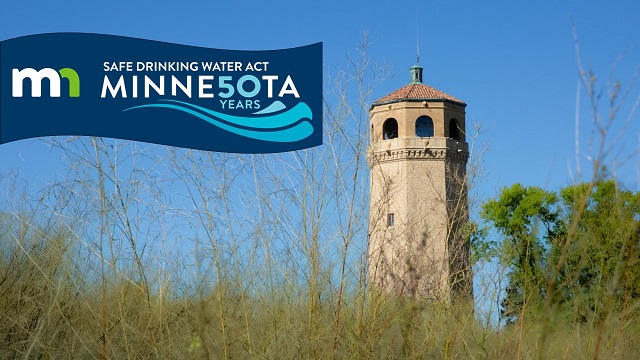
Governor Tim Walz proclaimed May 5-11 as Safe Drinking Water Week in Minnesota, and the Minnesota Department of Health (MDH) released its annual water quality report in conjunction with the week.
A special celebration was held this year because it is the 50th anniversary of the passage of the federal Safe Drinking Water Act.
Festivities included an event at the the state capitol with the ever-popular Water Bar, which offered samples from a number of Minnesota cities, along with a ceremony that included speeches by MDH commissioner Brooke Cunningham, Metropolitan Council Chair Charlie Zelle, and St. Paul Regional Water Services general manager Racquel Vaske.
The annual report, which has been released annually since 1995, highlighted the significance of the Safe Drinking Water Act and summarized the results of 2023 monitoring of public water systems in the state.
The report also covered strategic initiatives, including efforts to identify and address new contaminants; measures to protect residents from lead in homes, schools, and child-care facilities; infrastructure needs; resiliency in dealing with severe weather events; and health equity and affordable water as a human right.
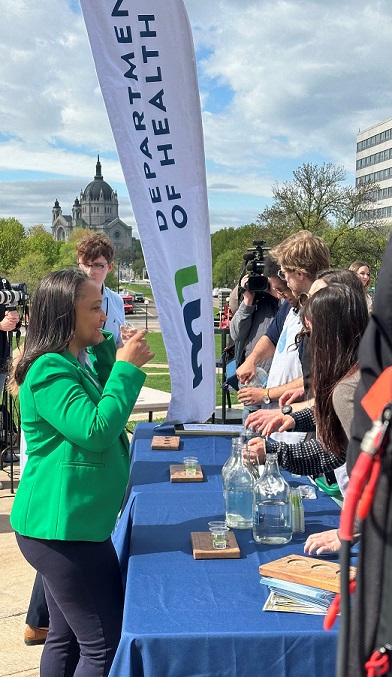
MDH commissioner Brooke Cunningham (left) samples water on the steps of the capitol during Safe Drinking Water Week in Minnesota.
Minnesota Drinking Water Annual Report for 2023 (PDF)
Safe Drinking Water Week in Minnesota Proclamation (PDF)
Safe Drinking Water Act 50th Anniversary Video
Go to > top
Success stories from the source

Treatment and monitoring are essential parts of providing safe drinking water, but protecting water sources from contamination is where it starts. The Minnesota Department of Health has been collecting success stories related to source water protection. Wetland restoration, collaboration with industry, well-sealing, and removal of underground tanks are among the stories coming from Pipestone to Pennock in Minnesota. Check out the MDH library, A Collection of Stories from the Source.
Go to > top
New treatment plant makes good water even better on Nagaajiwanaang
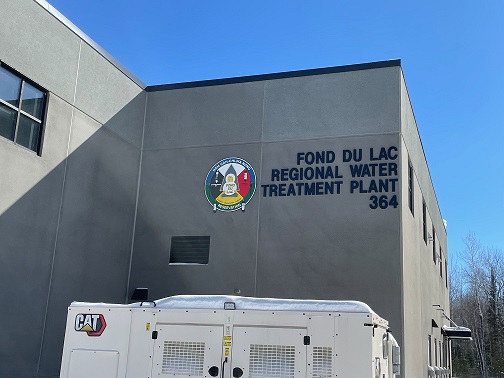
Nagaajiwanaang, “Where the Water Stops,” is the name of the homelands of the Fond du Lac Band of Lake Superior Chippewa at the time of the 1854 La Pointe Treaty. The band retained this name in Ojibwemowin for the present-day Fond du Lac Reservation, which was established under the 1854 treaty. The reservation covers nearly 160 square miles, most of it to the west of Cloquet, Minnesota, about 20 miles southwest of Duluth.
One of the last Ojibwe chiefs of the region, Joseph Naganub (Sits Ahead) represented his people in numerous treaty negotiations in Washington, D. C. Sits Ahead, who died in 1894, is buried in Holy Family Cemeteries along the St. Louis River in the northeast part of the reservation. Near him is the grave of a descendent, William “Nitchie” Cadreau, who in 1910 pitched one game in the major leagues, for the Chicago White Sox, under the name of Chief Chouneau.
A baseball diamond near the cemetery dates to the first half of the 20th century when the sport eclipsed lacrosse in popularity among the Ojibwe. However, in 2002 LeRoy DeFoe, the band’s cultural resources specialist, pointed out that the vocation and avocation of log rolling may have been even more popular than baseball. “You gotta understand this river here,” DeFoe said. “At one time it was the White Pine capital of the world. That river used to be full of logs all the way up almost to Brookston [one of the communities within the reservation], which is about 10 miles straight up north from here. That whole area was full of log jams.” DeFoe’s great-grandfather, Joe Medweiosh, is still known to long-time residents for his skill at tearing apart the logs and breaking the jams on the water.
On the topic of water, many of Nagaajiwanaang’s 2,700 bandmembers who reside within the reservation have private wells, some get their water directly from the city of Cloquet, and 126 homes – those in the Mahnomen and Danielson communities – have been supplied by a community water system since 1987.
The system has to comply with all requirements of the federal Safe Drinking Water Act, as do all public water suppliers. However, as a sovereign nation, the Fond du Lac water system is administered by Region 5 of the U. S. Environmental Protection Agency (EPA) rather than the Minnesota Department of Health. Minnesota has 11 federally recognized tribal nations, which often work with Midwest Assistance Program for training and with Bob Klug of Minnesota Rural Water Association for technical assistance for their water systems.
For close to 20 years, the Fond du Lac system operated with a pressure tank and the addition of chlorine. Two softening plants, using ion exchange, were built in the mid-2000s, in each of the communities. “Danielson had good water,” said utilities supervisor Adam Thompson, who grew up on the Fond du Lac reservation. However, because of high levels of total organic carbon (TOC) in the water, the Mahnomen plant struggled with disinfection byproducts. When the system received a violation for total trihalomethanes and haloacetic acids, it began working with SEH, Inc. to explore options and remedies.
John Thom of SEH said the water system worked with the EPA and federal Indian Health Service (IHS) to provide customers with home treatment units as they began a pilot study for the design and construction of a new plant about a mile west of Danielson and a mile-and-a-half southwest of the Mahnomen plant.

Adam Thompson and John Thom
The entire project included two new wells, five-and-a-half miles of water mains, 51 new hydrants, and a 75,000 gallon tower to go with the new 200 gallon per minute (gpm) treatment plant, which uses granular activated carbon (GAC) to reduce the TOC. The new wells are on the east side of the plant, and the water quality is superior in several ways to the previous wells.
The TOC in the raw water in this location is lower, approximately 2.5 parts per million (ppm) as opposed to around 12 ppm in the other wells. Thom pointed out that this level would be fine, if not for the addition of chlorine, which combines with the organic matter to produce the disinfection byproducts. A pair of GAC vessels reduce the organic compounds to allow for pre- and post-chlorination without the resulting byproduct issues.
Iron levels are low, but manganese is on the high side, 0.21 ppm, approximately four times the secondary standard. To ease the aesthetic issues caused by manganese, the plant has a pair of gravity filters with 12 inches of anthracite on top of 18 inches of GreensandPlus™, a black filter media used for removing soluble iron and manganese. Four inches of silica sand are at the bottom of the filter for nozzle protection.
The filters work with anthracite as the storage and greensand as the barrier. “You fill up that anthracite, and eventually it will push through the greensand,” said Thom, explaining the process. “Greensand is manganese dioxide. When you soak it in permanganate, you get manganese oxide, and that’s what removes the manganese. The soaking is important to build up that layer. Four ounces per cubic foot will give you that coating you’re looking for.”
The incoming water is also treated with gas chlorine. Thom said the pre-chlorine is “to get the oxidation to happen,” adding, “You want to come out the bottom with free chlorine, which means you’ve satisfied the demand for chlorine in that filter.”
After the gravity filters, the water flows into a clearwell and then is picked up by high service pumps and sent through the GAC filters. Ammonia is added as part of the post-chlorination to form chloramines, which aren’t as reactive as free chlorine and less likely to form trihalomethanes.
The total project came to between $14 and $15 million dollars and was financed through federal, state, and band funds. The band was grateful to leverage funds from U. S. Department of Agriculture Rural Development, the U. S. EPA, IHS, a Housing and Urban Development-Indian Community Development Block grant, and the Iron Range Resources and Rehabilitation Board to develop and construct the project.
On top of the other benefits, the raw water has 70 ppm hardness, an unusually low level for groundwater. “A lot of cities would kill for that water,” said Thom. “It’s quite unusual water.” He recalls being questioned by the IHS about the location of the treatment plant and wells and, in justifying the site, said, “That number. You pay big dollars to get down to 70 parts of hardness.”
The system does not charge its customers for the water, a nice benefit for residents but one that brings challenges. “It reduces their motivations to fix leaks,” said Thompson. The tribe visits homes and searches for leaks, working with the residents to get them fixed. Although most members of the communities served welcomed the new plant, a handful decided to keep their private wells. “We told them the benefits of hooking up to the regional plant, but they stayed on their own well,” said Thompson, noting that they did not force anyone to hook up.
As a community water system, the utility issues consumer confidence reports to its customers and follows other requirements of the Safe Drinking Water Act. Mike Lafave, Fond du Lac’s lead operator, worked with the IHS on lead service line inventories and has sent them to EPA for review. The system is new enough (its oldest service line was installed in 1986) that it has no lead in the system and has never had an issue with lead and copper sampling.
“This project was successful on a number of fronts,” wrote Fond du Lac public works manager Jordan Vandal, “including buy-in from the Reservation Business Committee, federal and state partners, engineers, and FDL staff who assisted in funding, design, construction and now operation and maintenance of the facility. FDL operations specialists have worked diligently on fine-tuning day-to-day operations to provide high quality, compliant drinking water, and I anticipate them to continue these efforts for Bandmembers which the Regional Drinking Water Treatment Plant serves.”
The new treatment facility opened in the late summer of 2023, and customers are happy with the water, none happier than Thompson, who lives in the Danielson community and said, “I was excited to be hooked up to this.”
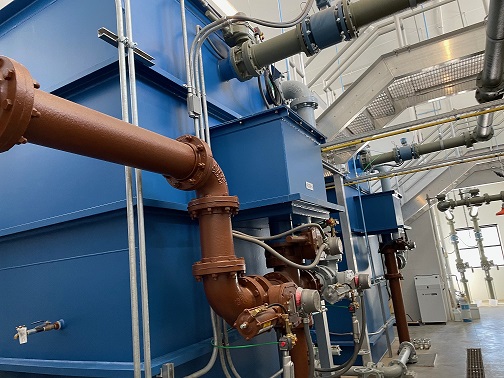
The gravity (above) and GAC filters (below)
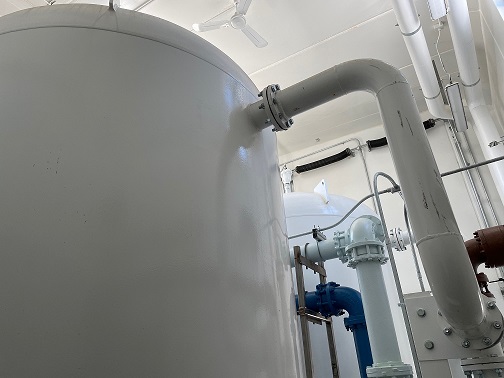
Go to > top
Art as a resource for water education and communication
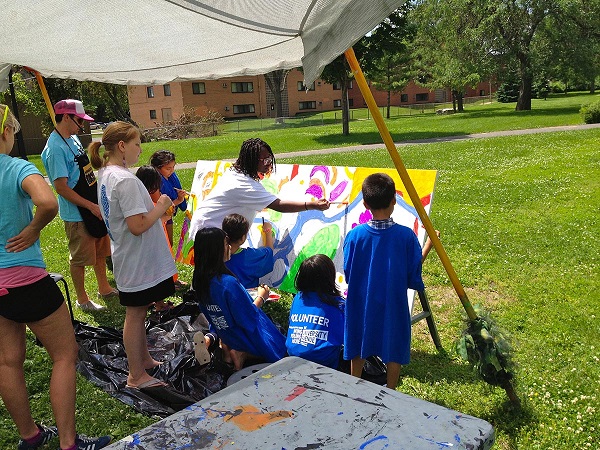
Public Art St. Paul has held educational programs on water for more than a decade, promoting knowledge and understanding through art and “make the invisible visible,” according to a past president. “The most memorable art conveys a message.” The photo above is of an educational program at Western Sculpture Park in St. Paul in 2014. Water Bar (below) is a combination of water, art, and social infrastructure that has been a hit around Minnesota for a number of years. As with other programs, these organizations have promoted messages about the importance of drinking water.

Waterline stories through the decades have focused on the role of art in communicating about water and raising awareness. (See the links to feature stories on the topic below.) Organizations such as In the Heart of the Beast Theater and Public Art St. Paul have been leaders in water education through art. The Source Water Protection Collaborative, highlighted in the Spring 2024 Waterline, reaches citizens through an artist-in-residence program as part of its mission to promote land use that protects drinking water sources.
On February 29, the Public Health Communications Collaborative (PHCC) hosted a national webinar about arts-focused approaches to public health communications. One of the presenters was Tasha Golden, director of the Research, International Arts + Mind Lab at Johns Hopkins School of Medicine. She focused on the question of “What Do We NOT Know?” regarding “so many populations and experiences that people cannot or will not share in ways we expect. . . . What do you not know about the people and communities you serve that we could learn if we tapped into more creative expression?”
An artist herself, Golden developed a creative-writing program for incarcerated teenage girls. “I don’t think it’ll surprise any of y’all to hear that girls share really different information in their poems and songs that they ever share on surveys or questionnaires or even in conversations sitting around a table,” Golden said, “because we tend to ask questions in such incredibly limited ways.”
The same could be said for our industry’s attempts to learn about attitudes and concerns related to drinking water. Standard methods of gathering information from citizens can be limiting, while artistic outlets may enhance expression. Water Bar has been such a means of combining water and art to get people to open up, an example of Golden’s sentiments: “The arts create intuitive occasions for people to gather, which creates opportunities to share knowledge and information to take collective action. . . . Arts have always been at the forefront of social movements because they can convene people.
“This is the wheelhouse of the arts.”
Another presenter on the February 29 webinar was David Fakunie, an assistant professor at the Morgan State University School of Community Health & Policy. Fakunie has used the art of storytelling in his work with public health. “We’re all storytellers,” he said. “It’s a universal art form, and it’s a universal science.”
Fakunie asked, “How do you want people to feel—not think—feel? The whole point of arts and culture is that it gives you all these different ways by which you can create the story and share it with people.”
As a lesson on the importance of conveying messages for those engaged in any field, including the water profession, Fakunie cited a a Zimbabwean proverb: “Until the lion tells his side of the story, the tale of the hunt will always glorify the hunter.” From this, he noted, “If you don’t tell your story, somebody else will.”
Past Waterline Articles
Public Art St. Paul Promotes Water Awareness
Minneapolis Theater Focuses on Water in Series of Performances
Go to top
H2O to Go on the road in St. Paul
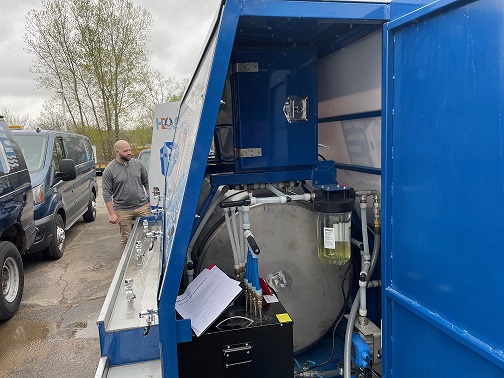
Above: H2O to Go has a 330-gallon tank in case a direct supply isn’t available. Below: Plumbers Steve Anderson and Tom Zangs disinfect the unit to prepare it for its first use.

From the visions of past and present general managers Pat Shea and Racquel Vaske, St. Paul Regional Water Services (SPRWS) has a water wagon for community events within its service area. Also called Quench Buggy (after the name of the company that built and supplied it), its official name is H2O to Go, based on a naming competition among SPRWS employees.
Steve Nystrom, the utility’s business innovation specialist, was in charge of the selection and design of H2O to Go, which arrived in St. Paul April 30. The wagon has four fountains and bottle-filling taps, including a lower one for accessibility, on each side of it. Also included is a spigot at the bottom for dog bowls.
On site, H2O to Go is jacked with trailer levels, carefully arranged to be slightly off-level for the drains at one end, allowing the excess water to flow to a graywater tank on the interior and be discharged later. Nystrom said they will disinfect the tank every week, using about a half-a-jug of bleach, letting it sit for 24 hours, and then testing the water.
At events, H2O to Go can be supplied by hydrants although a 330-gallon interior tank allows it to be pre-filled it if a hydrant isn’t available. The device has a solar panel to power the pumps and chiller.
The SPRWS Community Engagement Team will staff H2O to Go at events Employees split the duties of keeping the water wagon cleaned and sanitized while others talk to citizens drawn in by it.
H2O to Go made its informal debut and trial at a company picnic May 8 and was ready for its first appearance the next day, as part of an event with the Minnesota Department of Health at the state capitol in conjunction with Safe Drinking Water Week in Minnesota. Nystrom said they already have more than 20 events lined up for H2O to Go in 2024. “We’ve been working hard to get everything in order,” he said, adding that they will have a request page on their web site, St. Paul Regional Water Services.
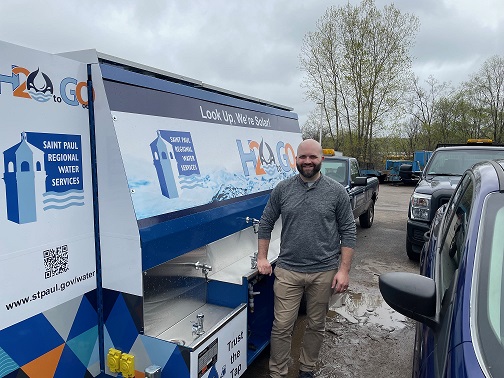
Above: Steve Nystrom makes sure all is well with H2O to Go. Below: SPRWS employees during the maiden voyage.
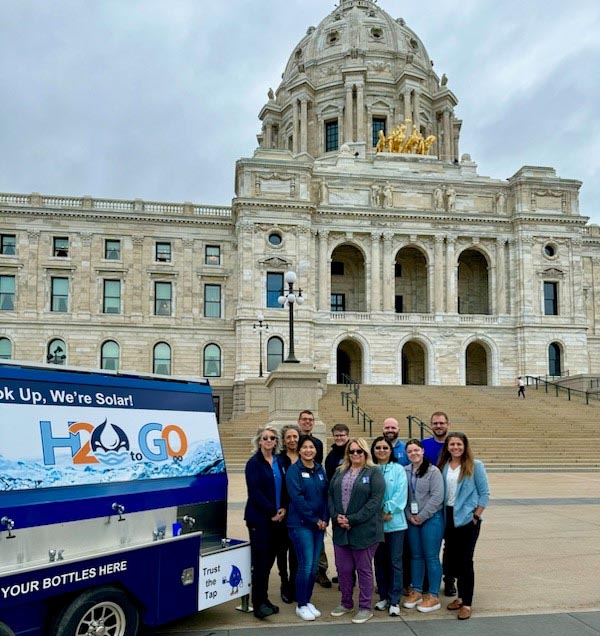
Go to top
Bernie Bullert featured in U of M Foundation publication
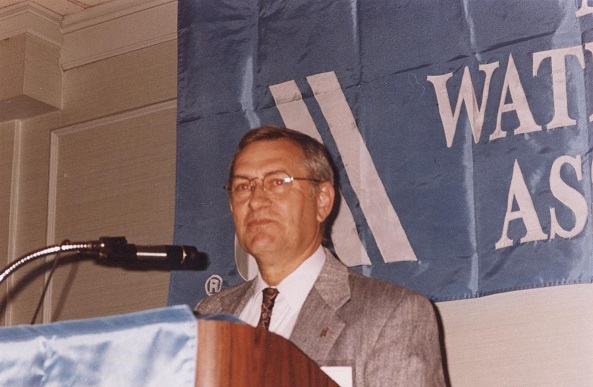
Bernie Bullert is well-known in the American Water Works Association, particularly the Minnesota Section, for a half-century of service to the drinking water profession that includes decades with St. Paul Regional Water Services, a dozen as general manager.
Bullert didn’t slide into retirement quietly, and his commitment to the study and management of water resources in the state drove him to create the Minnesota Water Research Fund at the University of Minnesota in 2015, which he funded with current and estate gifts.
The mission of the program is to provide research support for faculty and students in the U of M’s College of Science and Engineering’s Department of Civil, Environmental, and Geo-Engineering. The fund also helps train engineers and scientists, and the long-term goal is to endow a chair that will support U of M faculty who are international leaders in water research.
The University of Minnesota Foundation recognized Bullert with a front-page article in its quarterly publication, Making a Difference,” in an article titled “Water Visionary.”
Bullert points out that of the 900 community water systems in the state, many serve smaller cities that lack the resources needed to conduct research and make improvements. “We needed research to help the smaller communities that can’t afford to advance their systems,” he said in the article. “[The fund is intended to support projects that] are going to do the most good for the citizens of Minnesota.”
Go to top
Tools for lead and copper community site plans
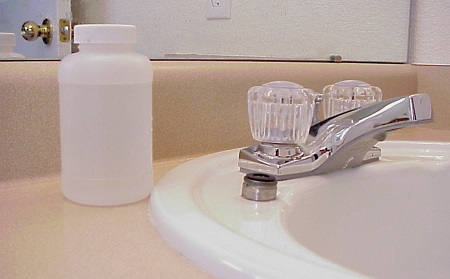
The U. S. Environmental Protection Agency’s Lead and Copper Rule requires community water systems to make sure the collection sites they are using are ones that are at the highest risk for elevated levels of corrosion. Community systems have to provide site plans to the Minnesota Department of Health (MDH) and receive approval prior to sampling.
Updates on the site plans and a link to a template are on-line:
Lead and Copper Site Plan Updates
Go to top
Infrastructure and cybersecurity
By Aaron Morningside, Cybersecurity and Infrastructure Security Agency (CISA)
Every day, water and wastewater treatment facilities across the country use a variety of techniques and an array of chemicals to purify water so that it is safe to use and drink. When used properly, these chemicals greatly benefit our society. However, some of the chemicals are dangerous and can be an attractive target for terrorists or criminals.
Through the years, water and wastewater facilities have been the target of nefarious incidents—from cyberattacks manipulating the amount of chemicals being released into the water to the theft of cylinders filled with dangerous chemicals. Could your facility be next? Enhance the security of dangerous chemicals at your facility and protect your community’s critical water supply by reaching out to CISA’s voluntary security program.
CISA offers programs to water and wastewater treatment facilities nationwide and offers no-cost services and tools to help identify the risk associated with your on-site chemicals. Our trained security advisors are located around the country and can help you understand the risks associated with your region, your on-site chemical holdings, and your facility’s existing security measures.
Because no two facilities are the same, CISA is available to help improve your security posture in a way that is tailored to your facility and your business model. From on-site assessments and assistance and security training, to physical and cybersecurity exercises, these resources are tailored for water and wastewater facilities, CISA has a variety of services and tools that can help your water and wastewater treatment facility enhance both your cyber and physical security.
Contact CISA with questions, CISARegion5@cisa.dhs.gov.
More information:
Defending OT Operations Against Ongoing Pro-Russia Hacktivist Activity
Enforcement activities to ensure drinking water systems address cybersecurity threats
The Safe Drinking Water Act (SDWA) Section 1433 requires community water systems (CWSs) serving greater than 3,3000 people to conduct a Risk and Resiliency Assessment (RRA), to update their Emergency Response Plan (ERP) based on what was learned in the RRA process, to certify to the Environmental Protection Agency (EPA) that both have been completed, and update both the RRA and ERP every five years. These plans include assessment of cybersecurity vulnerabilities.
EPA has taken over 100 SDWA enforcement actions nationally against CWSs for violations of Section 1433 since 2020, which was the first deadline for systems to develop and update their RRAs and ERPs. These enforcement actions have been based on various findings, including failure to certify, and not addressing the statutorily required elements in the RRAs and ERPs, which include looking at cyber threats.
EPA intends to use enforcement authorities to address problems such as failure to prepare adequate RRAs and ERPs. MDH will discuss RRA and ERP completion during sanitary surveys.
America's Water Infrastructure Act Section 2013: RRAs and ERPs
See also a May 20, 2024 Association Press article:
Go to top
PFAS may not be forever
Reprinted from the Spring 2024 issue of Minnesota Alumni with the permission of the University of Minnesota Alumni Association.
Polyfluorinated chemicals (PFAS) make everyday products resistant to anything from raindrops to burnt food residue. They’re also toxic; hazardous to humans, animals, and the environment; and extremely slow to break down, earning them the nickname “forever chemicals.” PFAS remediation has already cost billions of dollars, including a recent landmark 10.3 billion dollar lawsuit involving Minnesota-based 3M.
Some scientists say breaking down these chemicals biologically is impossible. But a team of U of M researchers wanted to understand why PFAS are so hard to remove from the environment. They identified an enzyme that can degrade fluorinated compounds and engineered a bacterium (called Pseudomonas putida ATCC 12633) to make the enzyme. Researchers then showed how and why the breakdown of the chemical is toxic to the bacterium and discovered a way to overcome that.
“Although the element fluorine has always been present on Earth, it was mostly bound up in rocks where living organisms were not exposed to it,” says coauthor Lawrence Wackett, a professor in the college of Biological Sciences. “Our study has laid a foundation that can make biological breakdown of PFAS in the environment possible and in an inexpensive and efficient way.”
This research originally appeared in the December 8, 2023 issue of mbio in an article with a really snappy title:
Also from the U of M:
How Socially and Culturally Diverse Minnesotans Value Water
Go to top
Words to Live and Die By
If I knew I was going to live this long, I would have taken better care of myself.
—Mickey Mantle
Live hard, die young, and make a good-looking corpse.
—Johnny Bench
Die before you get old. Oops, too late.
—Grandpa Simpson
Go to top
Reminder to all water operators
When submitting water samples for analyses, remember to do the following:
- Take coliform samples on the distribution system, not at the wells or entry points.
- Write the Date Collected, Time Collected, and Collector’s Name on the lab form.
- Attach the label to each bottle (do not attach labels to the lab form).
- Include laboratory request forms with submitted samples.
- Do not use a rollerball or gel pen (the ink may run).
- Consult your monitoring plan(s) prior to collecting required compliance samples.
Notify your Minnesota Department of Health district engineer of any changes to your systems.
Go to top
Calendar
Operator training sponsored by the Minnesota Department of Health and Minnesota AWWA will be held in the coming months.
Register for schools and pay on-line:
Go to top